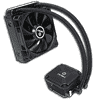 2
2
Enermax LIQMAX 120S Review
Noise Levels & Fan Speeds »Test System and Temperature Results
Test System
| Test System | |
|---|---|
| Processor: | Intel Core i7-4770K @ 3.7 GHz & 4.2 GHz OC (Haswell) |
| Motherboard: | MSI Z87-GD65 Gaming Intel Z87 |
| Memory: | 2x 4096 MB AMD Performance Edition AP38G1869U2K @ 1600 MHz 9-9-9-24 |
| Video Card: | AMD Radeon HD 5450 1 GB Passive |
| Hard disk: | OCZ Vertex Plus R2 60 GB SATA II SSD |
| Power Supply: | Deepcool Quanta DQ1250 1250W |
| Case: | LIAN LI PC-T60B |
| Operating System: | Windows 7 64-bit Service Pack 1 |
| TIM: | Arctic Ceramique 2 |
Testing Procedure
All testing is done at a room temperature of 23°C (73°F), with a 1°C margin of error. The coolers are tested with Turbo, EIST, and C1E enabled, which will allow the CPU to clock down to a low 1.6 GHz while idle, or clock up to proper speeds under stock and overclocked conditions. The retail Intel Core i7-4770K I use for testing at stock is set to load-optimized defaults with the CPU's voltage at a static 1.15 V. Overclocked, the processor is running at 4.2 GHz on the CPU and 3.9 GHz on cache, with respective voltages set to 1.20 V and 1.15 V. During all these tests, fans are set to run at 100% in the BIOS, with temperatures being recorded by AIDA64.The idle test will consist of the CPU sitting idle at the desktop for 15 minutes. This will allow for a stable temperature reading that will be recorded at the end of those 15 minutes.
Wprime's and AIDA64's CPU test represent typical multi-threaded loads. Both offer consistent results, with one being a benchmarking application and the other a stability test. Both are run for 15 minutes before the peak reading during the test is recorded and taken as the result. This test lets enthusiasts know what temperatures they can expect to see with games and applications. Wprime is set to eight threads while AIDA64 is configured to stress the CPU, FPU, cache, and system memory.
AIDA64 offers maximum heat generation when set to stress just the FPU in the stability test, which will really push the CPU. This test represents extreme loads much like LinX, Prime95, and other extreme stress tests many users are familiar with.
Idle Temperatures


The LIQMAX 120S looks great with the system in idle, at both stock and overclocked.
Typical Load Temperatures


Moving on to our first typical load-temperature tests, it is clear that the LIQMAX 120S is a solid performer in Wprime. At stock, it comes in 2°C behind the top air cooler, the Noctua NH-D15. That gap drops to 1°C with the overclock.


Pushing a heavier workload with AIDA64's CPU stability test again has the LIQMAX 120S put on a solid cooling performance. At stock, it places just 1°C behind the Deepcool Maelstrom 240. With the CPU overclocked, it falls back a bit to place 2°C behind the same 240mm all-in-one AIO cooler.
Max Load Temperatures


Using AIDA64's FPU stability test to push CPU load levels to the maximum, the Enermax LIQMAX 120S does very well. With the CPU overclocked, it falls in 3°C behind the Noctua NH-D15, though $25 less, while performing just as well as the Maelstrom 240. At stock, the LIQMAX 120S falls back a ways, but is ultimately only 2°C away from taking on several more expensive high-end air coolers. Interesting here is the fact that it performs much better with the overclock, rather than at stock.
Apr 7th, 2025 22:39 EDT
change timezone
Latest GPU Drivers
New Forum Posts
- is it worth using ssd with usb2? (10)
- Question about Intel Optane SSDs (70)
- USB case with dual USB-C and dual USB-A (6)
- The TPU UK Clubhouse (26058)
- Help me pick a UPS (88)
- Anyone with true HDDs still around here? (336)
- 12v lines 0 reads occansionally (2)
- Someone run games on AMD BC-250 under Linux * Cut down PS5 die to 6 CPU cores 24 GPU cores for use in crypto mining (79)
- RX 9000 series GPU Owners Club (236)
- The coffee and tea drinkers club. (246)
Popular Reviews
- The Last Of Us Part 2 Performance Benchmark Review - 30 GPUs Compared
- UPERFECT UStation Delta Max Review - Two Screens In One
- ASUS Prime X870-P Wi-Fi Review
- PowerColor Radeon RX 9070 Hellhound Review
- Upcoming Hardware Launches 2025 (Updated Apr 2025)
- Sapphire Radeon RX 9070 XT Pulse Review
- MCHOSE L7 Pro Review
- Corsair RM750x Shift 750 W Review
- Sapphire Radeon RX 9070 XT Nitro+ Review - Beating NVIDIA
- DDR5 CUDIMM Explained & Benched - The New Memory Standard
Controversial News Posts
- NVIDIA GeForce RTX 5060 Ti 16 GB SKU Likely Launching at $499, According to Supply Chain Leak (159)
- MSI Doesn't Plan Radeon RX 9000 Series GPUs, Skips AMD RDNA 4 Generation Entirely (146)
- Microsoft Introduces Copilot for Gaming (124)
- AMD Radeon RX 9070 XT Reportedly Outperforms RTX 5080 Through Undervolting (119)
- NVIDIA Reportedly Prepares GeForce RTX 5060 and RTX 5060 Ti Unveil Tomorrow (115)
- Over 200,000 Sold Radeon RX 9070 and RX 9070 XT GPUs? AMD Says No Number was Given (100)
- NVIDIA GeForce RTX 5050, RTX 5060, and RTX 5060 Ti Specifications Leak (97)
- Nintendo Switch 2 Launches June 5 at $449.99 with New Hardware and Games (92)